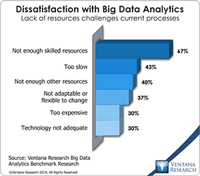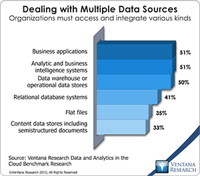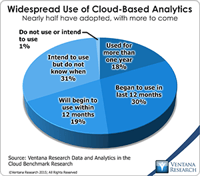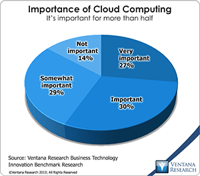The concept and implementation of what is called big data are no longer new, and many organizations, especially larger ones, view it as a way to manage and understand the flood of data they receive. Our benchmark research on big data analytics shows that business intelligence (BI) is the most common type of system to which organizations deliver big data. However, BI systems aren’t a good fit for analyzing big data. They were built to provide interactive analysis of structured data sources using...
Read More
Topics:
Big Data,
Predictive Analytics,
Software as a Service,
IT Analytics & Performance,
Operational Performance,
Analytics,
Business Analytics,
Business Intelligence,
Business Performance,
Cloud Computing,
Information Management,
Operational Intelligence,
Data,
Information Optimization
As I discussed in the state of data and analytics in the cloud recently, usability is a top evaluation criterion for organizations in selecting cloud-based analytics software. Data access of cloud and on-premises systems are essential antecedents of usability. They can help business people perform analytic tasks themselves without having to rely on IT. Some tools allow data integration by business users on an ad hoc basis, but to provide an enterprise integration process and a governed...
Read More
Topics:
Big Data,
Sales Performance,
Software as a Service,
Mobile Technology,
Customer Performance,
Operational Performance,
Analytics,
Business Analytics,
Business Collaboration,
Business Intelligence,
Business Mobility,
Cloud Computing,
Information Management,
Operational Intelligence,
Data
Our recently completed benchmark research on data and analytics in the cloud shows that analytics deployed in cloud-based systems is gaining widespread adoption. Almost half (48%) of participating organizations are using cloud-based analytics, another 19 percent said they plan to begin using it within 12 months, and 31 percent said they will begin to use cloud-based analytics but do not know when. Participants in various areas of the organization said they use cloud-based analytics, but...
Read More
Topics:
Big Data,
Software as a Service,
Operational Performance Management (OPM),
Analytics,
Business Analytics,
Business Collaboration,
Business Intelligence,
Customer & Contact Center,
Operational Intelligence,
Business Performance Management (BPM),
Data,
Information Optimization
At Oracle’s recent cloud computing analyst summit in sunny Palm Springs, the company’s executive team insisted that it sees clear skies for its efforts in cloud computing. The summit was led by senior executive Thomas Kurian, who runs the entire product organization and reports directly to CEO Larry Ellison. He affirmed that Oracle intends to offer the full range of cloud computing – public, private and hybrid models – to its customers and partners. As one of the world’s largest software...
Read More
Topics:
Big Data,
Database,
Microsoft,
SaaS,
Sales Performance,
Social Media,
Software as a Service,
Supply Chain Performance,
Middleware,
Oracle Cloud,
Operational Performance,
Business Analytics,
Business Collaboration,
Business Intelligence,
Business Performance,
Cloud Computing,
Customer & Contact Center,
Financial Performance,
IBM,
Information Applications,
Information Management,
Oracle,
Workforce Performance,
Database as a Service,
Verizon
This has been the year of the cloud for MicroStrategy. After ignoring early competition from cloud-based business intelligence (BI) providers, the company has jumped on the cloud BI bandwagon. At MicroStrategy Worldearly this year it announced a program called Cloud Intelligence and this summer introduced MicroStrategy Cloud, a complete BI platform with the option of using either IBM Netezza or ParAccel as the database and Informatica as the data integration environment. Now the company has...
Read More
Topics:
MicroStrategy,
SaaS,
Sales Performance,
Software as a Service,
Supply Chain Performance,
Operational Performance,
Business Analytics,
Business Intelligence,
Business Performance,
Cloud Computing,
Customer & Contact Center,
Financial Performance,
Visualization,
Workforce Performance














